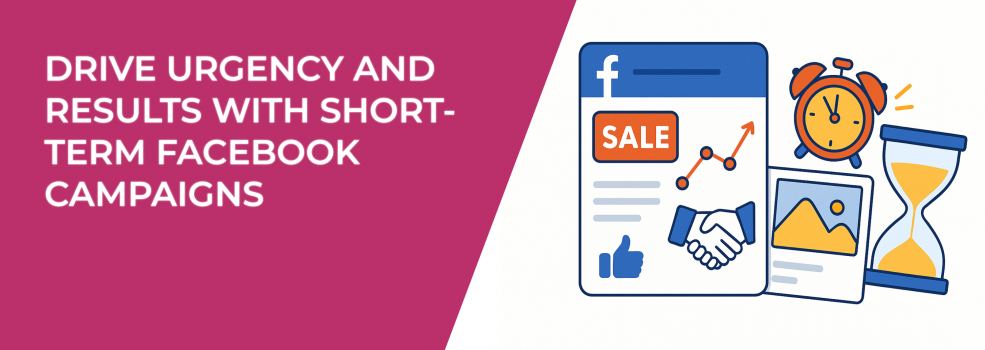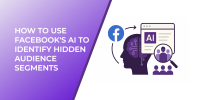Sometimes, running a long, slow campaign just doesn’t make sense. You’ve got a product you want to move, a promotion tied to a deadline, or maybe you’re simply trying to break through a lull in sales. In those moments, waiting for “the algorithm to learn” or “audiences to warm up” can feel like standing still while the clock’s ticking.
Short-term Facebook campaigns — ones that run for just a few days or a couple of weeks — can be a practical way to create momentum fast. They’re not a replacement for long-term brand-building efforts, but they are a smart tool when speed matters.
Let’s break down what makes short campaigns work, when to use them, and how to run them with intention.
Why short-term campaigns can work better
When you condense your ad effort into a shorter time frame, something interesting happens: every part of your campaign sharpens. You’re clearer about what you want people to do. Your budget is easier to manage. You cut out distractions and zero in on action.
It’s not just about urgency for your audience — it’s also about focus for you.
Why advertisers get strong results from short-term campaigns:
-
They’re easier to monitor. You can keep a close eye on performance without having to stretch across weeks or months.
-
They push for faster action. Whether it’s a countdown, a one-time bonus, or a deadline, the limited window makes the message feel more immediate.
-
They cost less upfront. You can run a test campaign with a smaller budget and still get valuable data in return.
-
They avoid fatigue. Long campaigns can bore your audience. Short ones hit harder and don’t overstay their welcome.
Think of it like this: instead of slowly dripping out your message over time, you’re dropping a focused burst of attention where it counts. This works especially well when your audience is already familiar with your brand or you’re offering something time-sensitive.
If your short campaign seems stuck or doesn’t deliver at all, you might run into the dreaded “Ad Set May Get Zero” warning — here’s what it means and how to fix it before it eats up your timeline.
Planning your campaign: simple, clear, and focused
A short campaign isn’t just a fast version of a long one. It needs a tighter plan, clearer messaging, and less room for error.
You need to know exactly what you're promoting and how that offer will connect with your audience in a very short window. There’s no time to warm people up or slowly build interest — your value has to come through immediately.
Here’s how to plan a solid short-term campaign:
-
Pick one goal. Are you trying to drive sales? Get signups? Promote an event? Choose one. If you try to do too much, you’ll lose impact.
-
Write a strong, time-based offer. Include language like “until Friday,” “this weekend only,” or “limited to 50 orders.” Be specific about when it ends and what people will miss if they wait.
-
Design with speed in mind. People scrolling past your ad should instantly understand what’s happening — no guessing, no long paragraphs, no vague slogans.
-
Keep the funnel tight. Make sure the landing page (if you’re using one) reflects the ad offer, with no distractions. The fewer steps to convert, the better.
For example, let’s say you’re running a campaign for early access to a new product. Your ad might say “Get 48-hour early access before launch day” with a clear CTA like “Reserve Now.” You’re not trying to tell your whole brand story — just give one compelling reason to act now.
Targeting the right people (and only the right people)
One of the biggest mistakes advertisers make with short campaigns is using broad or cold targeting. With limited time, you can’t afford to show ads to people who’ve never heard of you and hope something sticks. You need warm audiences — people who already know your business, have visited your site, or have shown some kind of interest.
Best audiences for short campaigns:
-
Website visitors from the last 30 days. They’re recent, they’re familiar, and they’ve already shown intent.
-
People who engaged with your Facebook or Instagram pages. Likes, comments, or even profile visits count — they’ve shown some curiosity.
-
Video viewers (especially 50%+ watched). These users have already spent time with your content and are more likely to respond to a time-sensitive offer.
-
Email lists synced with Custom Audiences. If you have a customer list, upload it and target those users directly.
Tips for targeting smart:
-
Keep your audience size manageable. 50,000 to 200,000 people is a good starting range for most short-term campaigns.
-
Use Lookalike Audiences only if you’re pairing them with urgency. Lookalikes work better when the ad creative makes people curious or excited fast.
-
Always exclude recent buyers or leads (unless it’s a re-engagement offer). You don’t want to waste budget on people who already converted.
This kind of tight targeting helps you make the most of a short campaign window. The more relevant your ads are, the faster they’ll perform — and the less money you’ll waste on cold clicks.
If you’re still figuring out who exactly you should be targeting, this step-by-step guide can help you nail your audience before you even open Ads Manager.
Building creatives that don’t waste time
You don’t need the most polished ad in the world — but it needs to grab attention, fast. In a short campaign, there’s no room for slow build-up. The offer, the value, and the deadline all need to be visible right away.
What makes a good short-term campaign ad?
-
Headlines with a time limit. “3 Days Only” or “Offer Ends Friday” grabs more attention than generic phrases like “Don’t Miss Out.”
-
Bold visuals. Whether it’s a static image or a short video, the design should be clean, easy to read, and scroll-stopping.
-
One CTA. Make the next step obvious — “Book Now,” “Get Access,” “Shop the Deal.” Don’t give users too many choices.
Videos can work well, especially if they’re under 15 seconds and use text overlays. But you can do a lot with a static ad too — just make sure your core message fits comfortably in a few words.
Also, keep your visuals consistent across placements. Your audience may see the ad in Stories, Feed, or Reels, and you want them to recognize it quickly, no matter where it appears.
If you’re short on time or design help, consider using AI tools to generate text and visuals that still meet quality standards — great for small businesses running lean.
Spend wisely: budgeting for short bursts
When running a short-term campaign, your budget should reflect the urgency. Spreading out a small budget over too many days can water down your impact — and you might not even exit the learning phase before the campaign ends.
Smart ways to handle budget for short campaigns:
-
Use daily budgets (not lifetime) for better control. Adjust on the fly if something’s performing well.
-
Start strong. Spend a little more in the first 1–2 days to help Facebook optimize faster.
-
Keep an eye on frequency. If people are seeing your ad too often, it may start to lose effectiveness. Aim for a frequency of 2–3 during the run.
If you're new to short campaigns, start with a moderate budget and a 5-day window. Check performance daily, and don’t hesitate to pause underperforming ads or shift spend to your best creatives.
After the campaign: don’t let the momentum fade
One of the best parts of short campaigns is how quickly they generate data. Don’t waste that.
Even if the campaign is over, the people who clicked or viewed your ads are still valuable. Now’s the time to follow up.
Here’s what to do after the campaign ends:
-
Retarget people who clicked but didn’t convert. They already showed interest — maybe they just weren’t ready yet.
-
Create a custom audience from engagers. Use this for future ads or email follow-ups.
-
Review your performance data closely. Which creatives worked? Which audiences converted? What didn’t work?
You can also use the campaign as a testing ground. Did certain messages or visuals perform better than others? Take notes, and use those insights in your next campaign.
When short-term campaigns make the most sense
These aren’t everyday strategies — but they’re incredibly useful in the right situations.
Best times to run a short campaign:
-
A seasonal or holiday promotion;
-
A new product release;
-
A last-minute sales goal;
-
A limited-time bonus or gift;
-
A test of new creative, copy, or offer structure.
In all of these cases, the goal is speed. When time is part of the message, short campaigns can create a stronger sense of purpose and push users to take action faster.
Final thoughts
Short-term Facebook campaigns aren’t about rushing — they’re about getting results quickly and intentionally. They require clear planning, sharp creative, and smart targeting. But when done right, they can bring in sales, leads, or engagement faster than traditional campaigns.
They also give you room to test ideas without committing to a full-month rollout. You can learn fast, iterate faster, and keep improving each time you launch.

